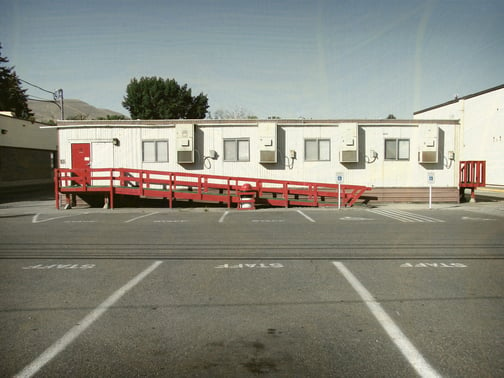We have all heard the phrase “the squeaky wheel gets the grease.” I have found this phrase to be particularly true when it comes to funding projects for space and facilities. When there is a portfolio of facilities – whether the facilities span a complex, region, nation, or the globe – the facilities inevitably compete for limited resources for maintenance, repair, and replacement. Often, the most “high profile” facilities receive the funding. These may be the largest facilities, those perceived to be the most “important,” and/or those that house politically connected personnel. But is this the right way to fund facility projects?
For over 30 years in my role as a court planning consultant, I have aspired to take politics out of the project funding equation. Instead, projects should be prioritized by urgency of need – i.e., where there is a critical need for facility improvements to provide for the safety of occupants or to significantly enhance the mission of the tenants. Determining urgency should be a data-driven process that taps into the most important drivers of facility needs for that particular organization.
For example, the need for a courthouse project may be deemed urgent when a courthouse lacks sufficient space for courtrooms and chambers, is deficient in critical security features, and/or is in a state of disrepair. The court may also have a growing caseload that will generate higher demand on the already inadequate courthouse. These issues – space and condition of the facility plus growing demand – combine to form an urgent need.
As another example, a hospital could be in disrepair with inadequate bed space and a lack of the medical programs and equipment needed to effectively treat many types of patients. The hospital could be located in an area with an increasing elderly population in need of medical services.
Similarly, a school could be in poor condition with many mobile classrooms clustered around the facility due to insufficient space in the main building. The surrounding community could have an expanding population base with an increasing number of school-aged children residing within the school district.

Portable school classroom
These examples have two things in common. First, urgency is defined by the declining condition of the facility and/or having inadequate space. Second, there is an element of increasing demand in the future. In my view, the best way to define urgency is a combination of existing facility metrics along with projections that shed light on potential facility demand in the future.
I once participated in a stakeholder meeting that was intended to define urgency for facility projects. One of the participants said, “You know it when you see it…the building is just crummy.” We joked about the technical term “crummy” for many years after this meeting. But the participant’s statement opened a dialogue about what makes a building “crummy,” and how do you tell which building is crummier than another? Below, I will address some of the steps in defining a crummy building that has the most urgent need.
Portfolio Assessment
The first step is to develop a process to assess all facilities within the portfolio. The process should be both objective and repeatable. Many organizations assess facilities using a facility condition index; however, this does not usually consider operations and security. We recommend a more holistic evaluation that includes the adequacy of the spaces to support the programs and mission, the facility’s security and safety features and deficiencies, and whether the space meets design standards. If there are no design standards established specifically for that portfolio, there are industry standards that can apply, such as the approximate size of a courtroom, classroom, or medical exam room.

One of the more challenging aspects of a portfolio assessment is developing the assessment factors. It may be necessary to hire an outside firm with an existing assessment process that is objective and that can be modified for your portfolio.
I find it most helpful to develop the factors by considering a logical progression through a facility, from the exterior to the entrance, then from the first floor to all other public areas of the building. In addition, any restricted access areas must be considered, including staff-only areas, building system and maintenance areas, the basement, and the roof. This logical progression helps think through the path the building tenants or members of the public may take. Along each step of this progression, factors should be identified for each of the main criteria.
Let’s consider the progression of a student arriving at school to highlight how factors can be developed.
- Facility Condition – The student will step off a school bus onto a curbside and progress to the school entrance. Are the curbside and sidewalk in good repair? Is the landscaping adequately maintained along the sidewalk to the front entrance?
- Security – Is there a camera monitoring the approach to the school? Is there adequate lighting in case students arrive or depart in the dark? Are there bollards or similar obstructions to block vehicular approach to the school entrance?
- Operations – Is the entrance readily identifiable and is there a logical progression from the bus drop-off area to the entrance? Is there an adequate number of entrance doors for the volume of individuals entering the building at peak times?
- Design Standards – Are the entrance doors solid core steel doors? Is there a handicap-accessible curb cut and ramp?
The above questions serve as examples of the types of questions that should be considered when developing factors. Some factors may simply require a simple yes/no response, but we have found that many factors have a range of possible responses that can be incorporated into an accompanying performance measure for each factor.
For example, let’s examine the issue of a security camera at the entrance to the school. A range of responses could be created as follows:
- Excellent – The entrance approach has full camera coverage with unobstructed views.
- Good - The entrance approach has full camera coverage but landscaping is blocking a portion of the view.
- Fair - The entrance approach has partial camera coverage (e.g., a single camera mounted on one side that does not fully cover the entrance, resulting in blind spots).
- Poor - There is no camera coverage of the entrance.
Assessing a portfolio will often require several hundred factors with accompanying performance measures. The process of developing the factors may seem a daunting process up-front, and it certainly is time-consuming when done properly. However, the assessment factors become an invaluable tool that can be used to assess facilities at any stage, and that help justify critical project funding decisions. It may be a wise investment to hire a firm that already has an established process and assessment tools, along with knowledgeable personnel who can objectively evaluate facilities and tailor their methods to the needs of your portfolio.
Adding Weights – Because Some Spaces Are More Important Than Others
Many times, there are critical operational spaces that are inadequate or missing in a facility. For example, courtrooms in courthouses, classrooms in schools, patient rooms in hospitals. If these spaces are undersized, in disrepair, or missing altogether, the mission of the organization is likely undermined. A thorough portfolio assessment includes factor weighting to emphasize the importance of critical spaces.
Weighting can be as simple as applying percentages to each of the criteria. For example, you might choose to weight the group of security factors higher than the group of factors related to design standards. Criteria weights should be set with a group of stakeholders familiar with the operations and facilities of a portfolio.
A process called “pairwise comparisons” can be used to weight the criteria, factors, and performance metrics. This results in a comprehensive set of assessment factors that together form a rigorous methodology for evaluating and assessing a portfolio of facilities. The next step is turning this assessment into a score, and prioritizing projects across a portfolio.
Rating Facilities
The factors and performance measures each receive a numeric score, allowing the individual factors to be numerically graded and for a score to be tabulated for each of the main criteria (facility condition, security, operations, and design standards in the example above). When tallied and run through the assessment model, the entire facility can then receive a score, typically between 1 and 100. A value of 100 would represent an ideal facility with respect to all of the factors included in the model.
It should be noted that in calibrating the rating process, pilot projects should ideally be performed to test how the ratings “work” for facilities of different sizes and missions, and to ensure that the factors are comprehensive.
Once finalized, the assessments can be performed on all facilities in the portfolio, with each facility receiving a score. It is a very powerful result when an entire portfolio has been scored. The facilities can then be rated from highest to lowest in terms of urgency of need. (Note: the assessment score must be converted to a “gap score” in the final analysis to determine need. For example, if a facility scored a 60, the gap score would be 40.)
I recommend that portfolio assessments be refreshed on a routine cycle. For example, every two to three years for a regional portfolio and every five years for a national portfolio. Such a cycle keeps the data current and helps maintain an objective view on the state of the portfolio.
Consider Demand
A final consideration for prioritization is the current and potential future demand on the facilities.
In considering demand, consider the “throughput” of a facility. In other words, what, or who, drives your workload? In a courthouse, the caseload is a major throughput. For schools, the throughput is students, and for hospitals, the throughput is patients. Determining throughputs requires gathering data on the drivers of need, which could include population, economics, workload, etc. There are too many methods for analyzing data to cover them all in this article, but consider your throughputs and forecast these throughputs at least 10 years into the future. Given the length of time it requires to plan, fund, design, and construct a major renovation project or new facility, you may want to produce even longer-term forecasts.

Once the data have been analyzed, the demand on a facility can also be assigned a score. For example, the facility with the highest projected growth could receive a “demand score” of 100, and so on. The demand scores should be calculated in a systematic way to ensure that the scores make sense when comparing the demand for one facility relative to another.
It should be noted that the demand scores should be refreshed periodically to ensure that emerging trends are considered and factored into the prioritization model. It is not uncommon for trends to shift in population bases and workload over time.
Prioritizing Projects
Once you have tabulated a physical assessment and a demand score for each facility, you now have a comprehensive view of the portfolio. Not only do you have a sense of how well the portfolio supports today’s mission, but you have data to show the projected magnitude of future demand.
I recommend combining these two scores using a weighted average, with the physical assessment gap score carrying a higher weight than the demand score. This is because the physical assessment score reflects the current reality and needs, while the demand score is based on a forecast and is more subject to change. For example, you might consider weighting the assessment score at 75% and the demand score at 25% in your model. You may also want to involve knowledgeable stakeholders in setting the weights. This can promote buy-in and lend validity to the process.
Without getting overly technical, it is important that the scales and weights are designed with consistency and rigor to ensure reliable results. When the gap score and demand score are combined, the higher the score, the more urgent the need for a project to address the facility need.
It is important that this process results in a credible “story” on why a facility need is urgent. For example, a courthouse is currently out of space and workload is projected to significantly increase. Or a school has classrooms that are already over-capacity and the local economy is expanding, bringing more families with young children to the area. Or, a hospital currently does not have enough beds for patients and routinely must refer patients elsewhere, and the fastest-growing segment of the population is people of retirement age, which will only increase demand on the hospital. These are all examples of the “story” that should be reflected by the prioritization process.
Preventing Politics
Employing such a systematic process will go a long way in determining true priorities so that decisions are not driven by politics or by the “squeaky wheel gets the grease.” I cannot emphasize strongly enough the importance of stakeholder involvement. If the stakeholders are removed from the process, they may view the resulting scores as a “black box,” the results of which are not credible. When stakeholder buy-in occurs, the logic of the process prevails. Stakeholders hoping for a project will generally trust the process and will wait their turn as they see their project getting closer to the top of the list. The ratings, weights, scores, and update process can also be used to communicate priorities in an objective manner.
The prioritization process is not easy to develop, but the results can be incredible in helping organizations make sense of competing priorities and in aligning funding with the greatest needs. After all, shouldn’t need – rather than politics or the loudest voice – dictate project priorities?





.jpg)




.jpg)


.jpg)
.jpg)
-1.jpg)
.jpg)
.jpg)
.jpg)
.jpg)
.jpg)

